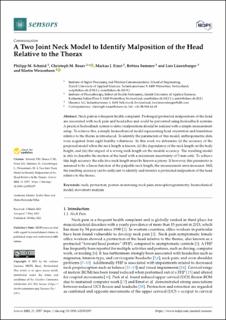Please use this identifier to cite or link to this item:
https://doi.org/10.21256/zhaw-22471| Publication type: | Article in scientific journal |
| Type of review: | Peer review (publication) |
| Title: | A two joint neck model to identify malposition of the head relative to the thorax |
| Authors: | Schmid, Philipp Matthias Bauer, Christoph Ernst, Markus Sommer, Bettina Lünenburger, Lars Weisenhorn, Martin |
| et. al: | No |
| DOI: | 10.3390/s21093297 10.21256/zhaw-22471 |
| Published in: | Sensors |
| Volume(Issue): | 21 |
| Issue: | 9 |
| Page(s): | 3297 |
| Issue Date: | 2021 |
| Publisher / Ed. Institution: | MDPI |
| ISSN: | 1424-8220 |
| Language: | English |
| Subjects: | Neck; Movement analysis; Protraction; Posture monitoring; Neck pain; Stereophotogrammetry; Biomechanical model |
| Subject (DDC): | 610: Medicine and health |
| Abstract: | Neck pain is a frequent health complaint. Prolonged protracted malpositions of the head are associated with neck pain and headaches and could be prevented using biofeedback systems. A practical biofeedback system to detect malpositions should be realized with a simple measurement setup. To achieve this, a simple biomechanical model representing head orientation and translation relative to the thorax is introduced. To identify the parameters of this model, anthropometric data were acquired from eight healthy volunteers. In this work we determine (i) the accuracy of the proposed model when the neck length is known, (ii) the dependency of the neck length on the body height, and (iii) the impact of a wrong neck length on the models accuracy. The resulting model is able to describe the motion of the head with a maximum uncertainty of 5 mm only. To achieve this high accuracy the effective neck length must be known a priory. If however, this parameter is assumed to be a linear function of the palpable neck length, the measurement error increases. Still, the resulting accuracy can be sufficient to identify and monitor a protracted malposition of the head relative to the thorax. |
| Further description: | This article belongs to the Special Issue Impact of Sensors in Biomechanics, Health Disease and Rehabilitation |
| URI: | https://digitalcollection.zhaw.ch/handle/11475/22471 |
| Fulltext version: | Published version |
| License (according to publishing contract): | CC BY 4.0: Attribution 4.0 International |
| Departement: | School of Health Sciences School of Engineering |
| Organisational Unit: | Institute of Physiotherapy (IPT) Institute of Signal Processing and Wireless Communications (ISC) |
| Appears in collections: | Publikationen Gesundheit |
Files in This Item:
| File | Description | Size | Format | |
|---|---|---|---|---|
| 2021_Schmid-etal_A-two-joint-neck-model-to-identify-malposition-of-the-head.pdf | 3.08 MB | Adobe PDF |  View/Open |
Show full item record
Schmid, P. M., Bauer, C., Ernst, M., Sommer, B., Lünenburger, L., & Weisenhorn, M. (2021). A two joint neck model to identify malposition of the head relative to the thorax. Sensors, 21(9), 3297. https://doi.org/10.3390/s21093297
Schmid, P.M. et al. (2021) ‘A two joint neck model to identify malposition of the head relative to the thorax’, Sensors, 21(9), p. 3297. Available at: https://doi.org/10.3390/s21093297.
P. M. Schmid, C. Bauer, M. Ernst, B. Sommer, L. Lünenburger, and M. Weisenhorn, “A two joint neck model to identify malposition of the head relative to the thorax,” Sensors, vol. 21, no. 9, p. 3297, 2021, doi: 10.3390/s21093297.
SCHMID, Philipp Matthias, Christoph BAUER, Markus ERNST, Bettina SOMMER, Lars LÜNENBURGER und Martin WEISENHORN, 2021. A two joint neck model to identify malposition of the head relative to the thorax. Sensors. 2021. Bd. 21, Nr. 9, S. 3297. DOI 10.3390/s21093297
Schmid, Philipp Matthias, Christoph Bauer, Markus Ernst, Bettina Sommer, Lars Lünenburger, and Martin Weisenhorn. 2021. “A Two Joint Neck Model to Identify Malposition of the Head Relative to the Thorax.” Sensors 21 (9): 3297. https://doi.org/10.3390/s21093297.
Schmid, Philipp Matthias, et al. “A Two Joint Neck Model to Identify Malposition of the Head Relative to the Thorax.” Sensors, vol. 21, no. 9, 2021, p. 3297, https://doi.org/10.3390/s21093297.
Items in DSpace are protected by copyright, with all rights reserved, unless otherwise indicated.